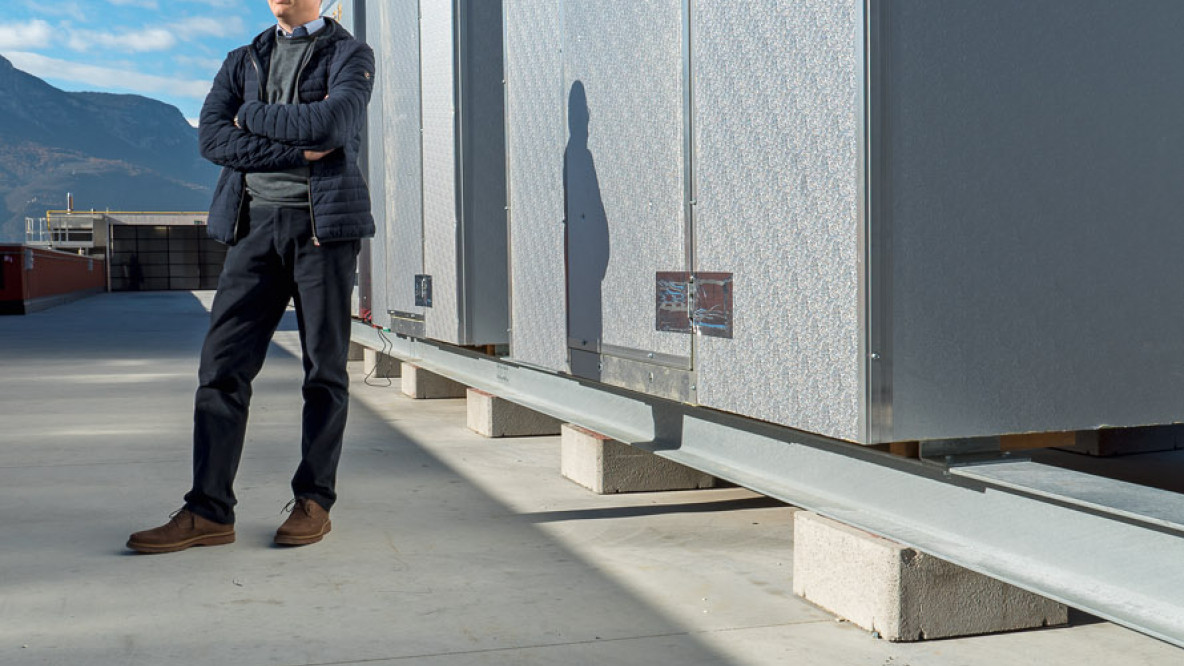Your comfort is their top priority!

Their study of the various materials, components and technologies used in the construction of buildings is contributing to our understanding of what makes people comfortable and how improving comfort improves efficiency.
by Michael Joseph Ennis
Andrea Gasparella and his team of researchers study the physics of buildings, specifically how the various materials, components and technologies used in buildings contribute to the indoor environmental quality. Their research encompasses the net impact building materials—such as materials used to construct windows and walls—and building technologies—such as heating, ventilation and air conditioning systems—have on the physical behavior of a building and on the well-being of occupants.
Much of Gasparella’s research expectedly focuses on the energy performance and environmental impact of buildings. But his research treats energy management as a secondary concern. He is quick to remind you that the primary purpose of any building is not to save money or conserve energy, but to ensure that the indoor conditions are suitable for the occupants.
Achieving the “net-zero energy” building is a noble and worthwhile goal from both a scientific and a social point-of-view, but the challenge is making energy efficiency a practical objective in real buildings. Each building must be designed, first and foremost, with the needs of the intended occupants in mind. In fact, the quality of life of the people residing, learning, shopping or working in buildings will be the primary object of study at the new Building Physics Lab at the NOI Techpark.
Each building must be designed, first and foremost, with the needs of the intended occupants in mind. (Prof. Andrea Gasparella)
Comfort = Efficiency
The comfort of the occupants in every aspect—thermal heat, air flow, humidity, acoustics, lighting—is also in the best interest of society and all stakeholders—local and national authorities, policymakers, the constructors and owners of buildings—in that the occupants’ well-being correlates with measures of productivity, customer satisfaction and health. Losses in any of these measures can offset any reduction in energy costs.
The factory worker may not be able to work productively for a full shift if the air temperature is too high. The office worker may not be able to work at the computer if there is too much glare on the screen. The customer may never return if there is a cool draft in the restaurant during the winter. The student may underperform on the exam if the humming of the air conditioner in the classroom is too loud. And the resident may have trouble sleeping at night if the air quality in the bedroom is poor.
Occupants often react to such uncomfortable conditions by mismanaging the building’s environmental systems: opening the window during the winter if the heater is turned on too high or turning on the light during the day if insufficient light is coming through the window. More importantly, safety and health issues may arise from poor environmental quality, as poor conditions increase the frequency of accidents and the risk of getting sick.
A building’s “envelope” consists of walls, windows, ceilings, floors, doors and a roof, each made with different opaque and transparent materials, and the indoor environment is defined by multiple physical properties, including temperature, lighting, acoustics, and humidity. (Prof. Andrea Gasparella)
The “Multi-Objective” of Building Design
For these reasons, Gasparella’s first concern is the indoor environment of buildings, rather than the natural environment outside. Gasparella’s research adopts a “multi-objective” and “multi-domain” approach to building design, where the aim is to minimize the costs of construction and maintenance and the consumption of energy in all building processes and functions, while maximizing the quality of life of the occupants.
He relies on three types of experiments to study the impact various building materials and technologies have on the indoor environment: controlled experiments in labs, experimental simulations in realistic mock-ups, and field experiments in real buildings.
In the lab, Gasparella’s team might compare the performances of various opaque materials used in the construction of walls, for example, in terms of their abilities to insulate or absorb heat. Such simulations produce important data, but offer an incomplete picture.
Most people perceive a wall as a two-dimensional barrier, which simply protects occupants from the extreme conditions of the external environment. In reality, a wall is a three-dimensional, multi-material, and multi-component space which dynamically filters the physical properties of the external environment while simultaneously responding to the internal properties. In order to regulate the conditions of the internal environment, it is of crucial importance to understand the behavior of walls under realistic operating conditions.
Furthermore, a building’s walls are but one element in a complex whole, and heat is but one property of the indoor environment. A building’s “envelope” consists of walls, windows, ceilings, floors, doors and a roof, each made with different opaque and transparent materials, and the indoor environment is defined by multiple physical properties, including temperature, lighting, acoustics, and humidity. In addition, modern buildings have complex energy management systems to control temperature and air quality. Gasparella’s team uses building mock-ups to study how each of these elements operates as part of a complex system which dynamically regulates the indoor environmental quality.
Understanding these types of interactions can help building designers better calibrate artificial lighting or heating and cooling systems in order to improve the comfort of the occupants and thereby reduce energy waste and costs. Yet a mock-up is just a model. In the future, Gasparella’s team will conduct field experiments in actual residences, schools, and workplaces in order to study how the various materials and components interact with one another as dynamic systems, as well as how the human occupants respond to the systems in the real world. The researchers will rely upon mixed methods involving both quantitative and qualitative data, such as mathematical models and equations, which predict how human occupants perceive and react to the properties of an internal environment, as well as questionnaires and surveys, through which the occupants share their experienced sensations and interactions. The best sensor of human comfort is, after all, a human being!
The purpose of the research is not necessarily to develop new technologies and materials, but to understand the performance of new products or products already available on the market, and to troubleshoot instances of underperformance. Certain products obviously outperform other products in certain conditions. But underperformance is typically caused by inappropriate applications, rather than flaws in product design. Thus, the research often aims at finding the appropriate application for each product. Once the strengths and weaknesses of particular materials or products are known, however, the team can also support companies in research and development.
The ultimate goal is to contribute to the design of “high performance buildings” capable of self-regulating an indoor environment ideal for human occupants.
In the end, focusing on the comfort of occupants combines the economic, the social, and the environmental requirements of buildings. Spending a little more money on ensuring comfort now can turn into long-term gains in productivity, efficiency, sustainability, and profitability. (Prof. Andrea Gasparella)
Realizing the Buildings of the Future
Gasparella predicts that the buildings of the future will likely have no, or only limited-use, heating and cooling systems, but that they will still require mechanical ventilation systems. Various forms of thermal insulation and solar energy can already regulate ideal indoor lighting and temperature, but it is very difficult to manage air quality using only natural ventilation, especially in crowded contexts.
And human beings always require fresh air!
In the future, the team will therefore study heat recovery ventilation systems, which self-regulate the temperature of incoming air by transferring heat to or from the outgoing airstreams.
In the end, focusing on the comfort of occupants combines the economic, the social, and the environmental requirements of buildings. Spending a little more money on ensuring comfort now can turn into long-term gains in productivity, efficiency, sustainability, and profitability.
The new Building Physics Lab at the NOI Techpark will give Gasparella and his team of approximately a dozen researchers—including PhD students, postdocs, contract researchers, and technicians—the space and the modern equipment required to run simulations and analyze complex data sets, including a new rooftop mock-up, which can simulate almost any kind of building. The team will be relocating to their new office spaces by the end of 2018. Research in the new labs will commence in 2018.
Academia, Magazine of unibz & EURAC
